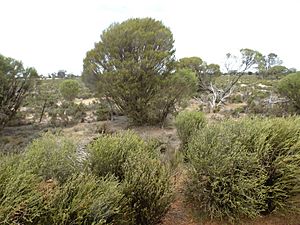Gorada facts for kids
Quick facts for kids Gorada |
|
|---|---|
 |
|
| M. lateriflora growing near Wagin | |
| Scientific classification | |
| Genus: |
Melaleuca
|
| Species: |
lateriflora
|
The Gorada (scientific name: Melaleuca lateriflora) is a cool plant that belongs to the myrtle family, called Myrtaceae. You can only find it growing naturally in the south-west part of Western Australia. It's usually a straight-growing bush with oval-shaped leaves. It also has small groups of white flowers that mostly grow along its older branches.
Contents
What Gorada Looks Like
The Gorada plant, or Melaleuca lateriflora, is a bushy shrub. It has rough, grey-brown bark and usually grows to about 4 meters (13 feet) tall. Sometimes, it can even grow taller! Most of its leaves and branches are smooth, except for the very youngest ones.
Its leaves grow one after another along the stem. They are about 4 to 12 millimeters (0.16 to 0.47 inches) long and 3 to 6 millimeters (0.12 to 0.24 inches) wide. Their shape can be different, from long and thin to oval, and they usually have a short, pointed tip.
The flowers are white or a light cream color. They grow in groups up to 90 millimeters (3.5 inches) long and 12 millimeters (0.47 inches) wide. Each group can have up to 15 flowers. These flower groups appear on the wood from the year before, and sometimes near the ends of the branches. The small petals are about 1.2 to 2.3 millimeters (0.047 to 0.091 inches) long and fall off quickly after the flower opens.
Around each flower, there are five groups of stamens (the parts that hold pollen). Each group has 6 to 13 stamens. You can usually see these flowers between September and January. After the flowers, the plant grows woody fruits. These fruits are like small capsules, about 3 to 5.5 millimeters (0.12 to 0.22 inches) long and 4 to 5 millimeters (0.16 to 0.20 inches) wide. You can still see the sepals (leaf-like parts that protect the bud) on the capsules.
How Gorada Got Its Name
The scientific name Melaleuca lateriflora was first officially described in 1867 by a scientist named George Bentham. He wrote about it in a book called Flora Australiensis.
The second part of its name, lateriflora, means "flowers on the side." This is because its flower groups grow on the small branches and main branches below the leaves. For a while, there were two types of Gorada, but in 2010, one of them became its own separate species called Melaleuca acutifolia.
Where Gorada Grows
The Gorada plant grows in many areas of Western Australia. You can find it from the Yuna and Mullewa areas in the west, all the way east to the Coolgardie area. It also grows south to the Stirling Range.
It likes to grow in sandy and clay soils. You can often spot it on flat lands, in areas that sometimes flood, and in swampy places.
Conservation Status
Good news! The Gorada plant is currently listed as "not threatened" by the Government of Western Australia's Department of Parks and Wildlife. This means it's not in danger of disappearing.
Images for kids
-
Habit near Wagin




